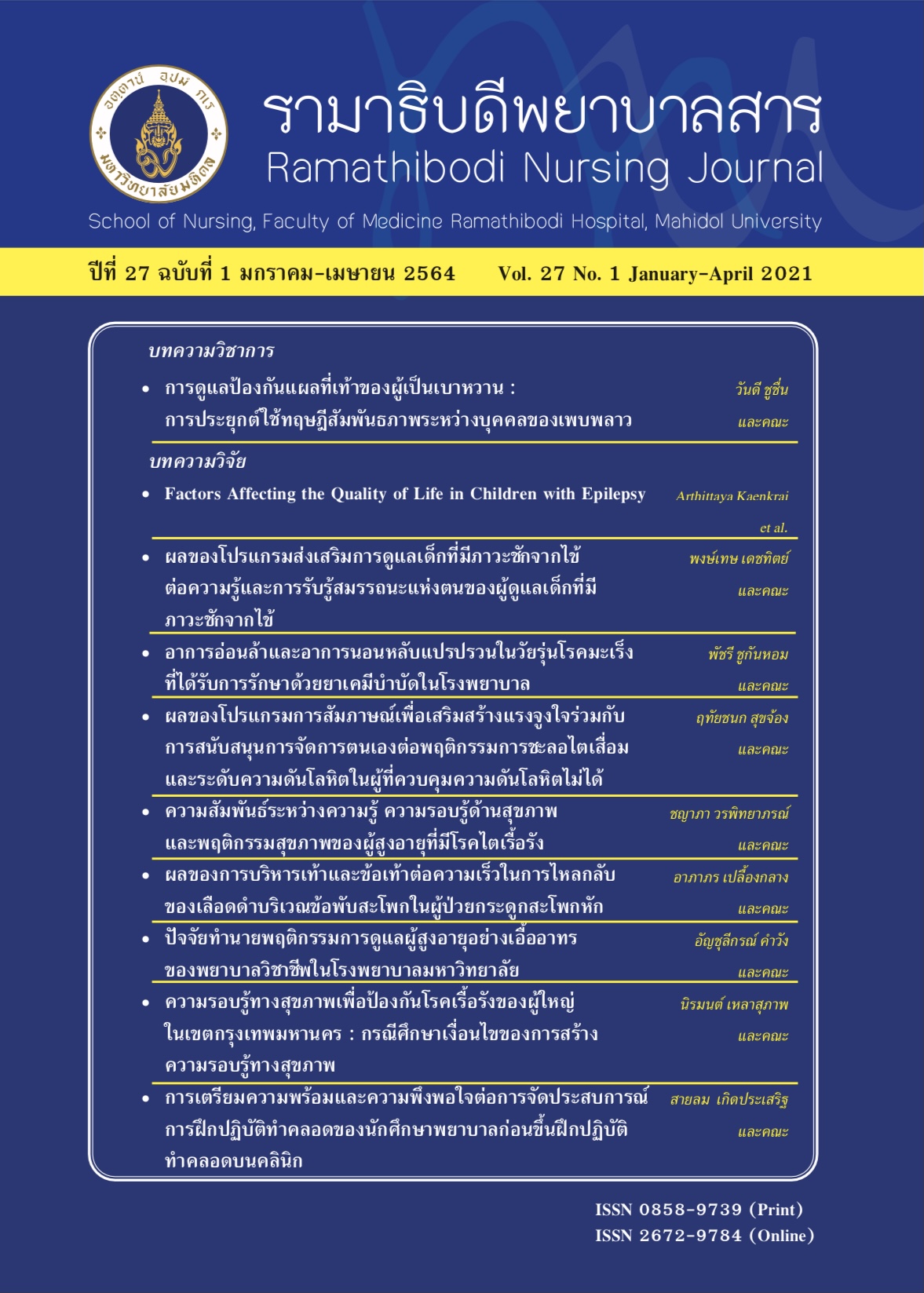Factors Predicting Professional Nurses' Caring Behavior for Older Persons in a University Hospital
Main Article Content
Abstract
This research aimed to examine the predictability of selected factors to explain caring behavior for older persons of professional nurses in a university hospital. The Theory of Reasoned Action was used as a conceptual framework to guide this study.Proportional stratified sampling was used to recruit a sample of 150 professional nurses who cared for older persons at a university hospital. Data were collected from April to June 2019, using 6 self-administered questionnaires to assess personal data, basic knowledge about older persons, attitude toward caring for older persons, perceived caring climate, intention to care, and caring behavior for older persons. Then, Spearman’s rank correlation and multiple regression with the Enter method were used for the data analysis.The findings revealed that the attitude toward caring for older persons, perceived caring climate, and intention to care were significantly, positively related to caring behavior for older persons. Through multiple regression analysis, the perceived caring climate,
intention to care, attitude toward caring for older persons, and basic knowledge about older persons jointly accounted for 32% of the variance in caring behavior for older persons of professional nurses. The perceived caring climate was the strongest predictor of caring behavior. It is suggested that perceived caring climate in an organization,attitude toward caring for older persons, and intention to care should be promoted to
enhance professional nurses’ caring behavior.
Keywords: Intention to care, Caring behavior, Professional nurses, Older persons, Theory of Reasoned Action
Article Details
บทความ ข้อมูล เนื้อหา รูปภาพ ฯลฯ ที่ได้รับการตีพิมพ์ในรามาธิบดีพยาบาลสาร ถือเป็นลิขสิทธิ์ของวารสาร หากบุคคลหรือหน่วยงานใดต้องการนำทั้งหมดหรือส่วนหนึ่งส่วนใดไปเผยแพร่หรือเพื่อกระทำการใด ใด จะต้องได้รับอนุญาตเป็นลายลักษณ์อักษรจากรามาธิบดีพยาบาลสารก่อนเท่านั้น
References
Assantachai P. Common health problem in elderly and prevention. Bangkok: Union Creation; 2009.
Inouye SK, Studenski S, Tinetti ME, Kuchel GA. Geriatric syndromes: clinical, research and policy implications of acore geriatric concept. J Am Geriatr Soc. 2007; 55(5):780–91.
Ham RJ. Primary care geriatrics: a case-based approach.5th ed. Elsevier Health Sciences; 2007.
Sasat S. Gerontological nursing: common problems and caring guideline. 3rd ed. Bangkok: Active print; 2011.
Jitmontree N, Thongcharoen W, Thanasilp S. Good model of elderly care in family and community in city and
Bangkok. J Nurs Sci. 2011;29(2):67-74.
Wilson LD. The American Association of Colleges of Nursing’s geriatric nursing education consortium. J
Gerontolol Nurs. 2012;36(7):14-7.
Malathum P. Successful aging. Rama Nurs J.2007;13(3):221-31.
Thongcharoen W. Nursing science and arts. 2nd ed.Bangkok: NP Press; 2015.
Leethong-in M, Piyawattanapong S. Predicting factors of age-friendly nursing care behavior by nursing studentsnursing practice subject. Journal of Nursing and Health Care. 2015;33(3): 70-9. (in Thai)
Rerksadayut P. Caring behavior of perioperative nurses and related factors as perceived by perioperative nurse [Thesis]. Songkla: Prince of Songkla University; 2013.
Ajzen I, Fishbein M. Understanding attitudes and predicting social behavior. Englewood Cliffs NJ: Prentice-
Hall; 1980.
McKinlay A, Cowan S. Student nurses’ attitudes towards working with older patients. J Adv Nurs. 2003; 43(3),
-309.
Oyetunde MO, Ojo OO, Ojewale LY. Nurses’ attitude towards the care of the elderly: implications for
gerontological nursing training. J Nurs Educ. 2013;3 (7):150-8.
Faul F, Erdfelder E, Lang AG, Buchner A. G*power 3: a flexible statistical power analysis program for the social,behavior, and biomedicalsciences. Behave ResMethods.2007;39(2): 175-91
Dikken J, Hoogerduijn JG, Oeseburg, B, Venables H,Habes V, Schuurmans MJ, et al. Educating for an aging
society: competencies, knowledge and attitude and how to motivate students. J Adv Nurs. 2016;72(S1);8
Hughes L. Peer group caring interaction scale and organizational climate for caring questionnaire. In: Watson
J, editors. Assessing and measuring caring in nursing and health sciences. 2nd ed. New York: Springer; 2009. p.
-62.
Fishbein M, Ajzen I. Predicting and changing behavior:the reasoned action approach. New York: Psychology
Press; 2010.
Suebwonglee C, Suchewa S, Wongwanich S. Development of a nursing caring behavior assessment instrument using the cognitive interview technique. SDU Res J. 2011;7(2):127-42. (in Thai)
Ko NY, Feng MC, Chiu DY, Wu M H, Feng JY, Pan SM.Applying theory of planned behavior to predict nurses’
intention and volunteering to care for SARS patients in southern Taiwan. Kaohsiung J Med Sci. 2004;20(8):389-98.
Javadi M, Kadkhodaee M, Yaghoubi M, Maroufi M, Shams A. Applying theory of planned behavior in predicting of patient safety behaviors of nurses. Mater Sociomed.2013;25(1):52-5.
Jeong SY, Park HS, Wang HJ, Kim M. Intentions to care for new influenza A (H1N1) patients and influencing
factors: an application of theory of planned behavior. J Korean Assoc Soc Home Care Nurs. 2015;22(1):78-87.
Kim CJ, Yoo HR, Yoo MS, Kwon BE, Hwang KJ.Attitude, beliefs, and intentions to care for SARS patients
among Korean clinical nurses: an application of theory of planned behavior. J Korean Acad Nurs. 2006;36(4):
-603.
De Guzman AB, Jimenez BCB, Jocson KP, Junio AR,Junio DE, Jurado JBN, Justiniano ABF. Filipino nursing
students’ behavioral intentions toward geriatric care: a structural equation model (SEM). Educ Gerontol.
;39(3):138-54.
Hagerling FL. Nurse attitudes toward caring for older
patients with delirium [Dissertation]. Colorado: Colorado
State University, USA; 2015.


